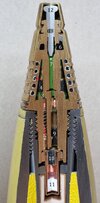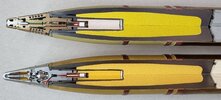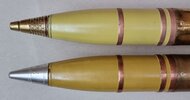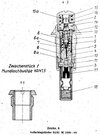Cutaway model of a “Obus de 75mm explosive modele 1928 D.C.A” (HE shell mark1928) for the French “Canon de 75mm contre aeronefs modele M17/34, M30, M33 en M36” anti aircraft guns. In 1939 these were the most modern pieces of AAA the French had in service, however only few were available. The Germans confiscated a number of these guns after the invasion of France in 1940 and put them in their own use as the “7,5cm Flak M17/34(f), M30(f), M33(f), M36(f)” or as the 7,5cm Flak 36 (Schneider)
The projectile is fuzed with the Swiss “Dixi” mechanical time fuze, which was called “fuse modele 1939 a mouvement d’horlogerie” when in French service, and Zt.Z. 30/45 M39A when used by the Germans.
The fuze is screwed into the steel booster bushing. Below the fuze (in the bushing) a thin brass bushing is placed which houses the booster charge. The steel booster bushing is screwed into the projectile body.
The projectile body is filled with 684 gram M-Dn (Melinite-Dinitroaphtaline) or a mixture of Picrine acid and Dinitroaphtaline.
Functioning (simplified) of the “fuse modele 1939 a mouvement d’horlogerie” :
The fuze is build up of a lower body in which a rotor is placed with a gear wheel on top. On top of this rotor a speed reduction gear housing is placed, which is connected to the nose cap.The reduction gear is locked up by a threaded ring whitch fits over the top part of the fuze body.
On the inside of the fuze body , a conical rounded thread is machined, which ends into a chamber which houses the firing pin and the fring cap. The conical rotor has four longitudal slots (at 90 degr each) in which a ball is placed. The balls are locked up, half in the longitudal slot, half in the conical thread.
Upon firing the shell, the centrifugal force will throw the balls outward, forcing them upward in the rounded conical thread. This forces the rotor to rotate. The gearwheel on top of the rotor is connected to the reduction gear box above it, slowing the rotating movement of the rotor. On the end of the reduction gearbox an escapement is placed that enshures the gearbox speed is constant. The speed of this escapement is regulated by a balance on a torsion wire. This wire is placed in the tube in the nose cone. Before firing the balance is fixated by a non return set back weight on a spring. Upon firing, the weight sets back, enabeling the balance to start it’s oscilating movement.
By rotating the nosecap the balls in the groove rotate upward; the further the nosecap is rotated anti clockwise, the further the balls move into the direction of the end of the groove where the chamber with the firing pin and firing cap (orange) are located, the shorter the setting time of the fuze. With the fuze in safe position, the balls are in the lowest position, so shortening the setting time is done by rotating the balls upward. In contrast to most fuzes that count from zero to the required time, this fuze is set from maximum time to the required time.
When the set time is expired, the ball falls out of the groove into the chamber; the centrifugal force swings the ball on the firing pin with force. The firing cap is ignited by the ball, the flame travels downward through the angled red hole where it ignites the black powder booster pellet. The flame than travels downward through the vertical red hole into the detonator (white), igniting the projectile.
The shellcase is the “Douille modele 1928” (shellcase model 1928 / Patronenhulse modell 1928). It is filled with 1250 grams of BG-5 taper powder (87x17x1,35mm), packed into five packs of 250 grams, bound together with two pieces wire.
The brass M97 percussion base igniter contains 4,4 grams of black powder which forms the ignition charge for the main charge in the shellcase.
On top of the powdercharge a rolled up bundle of lead wire is placed, which acts as an anti fouling agent when using red copper driving bands. In the corners of the lands and fields copper of the driving band remains after firing a projectile. The lead vaporizes upon firing, forming a brittle alloy of red copper and lead. This is pushed out of the barrel with the next shot.
Weight of complete cartridge : 9,5 kg
Weight of fuzed projectile : 6, 17 kg
Length of complete cartridge : 840mm
Length of projectile : 383 mm
Length of shellcase : 518mm
Vo : 700 mtrs/sec (2297 ft/sec)
Max ceiling : 8200 mtr. (26900 ft.)
Length of barrel : L/54 (4050 mm)
An interesting detail with this cartridge is the fact that the shellcase as well as the fuze both have German stamps. The shellcase has the French stamping 75 F.B LUM 23 with the added German Waffenamt stamps “WaA C60 (or 80)” below the eagle with the swastika in a ring.
The fuze is stamped PA 89 a 43 with the added German stamps “WaA 358” below a simplified German eagle with a swastika.
One could safely assume that this French shell was a part of the spoils war that fell into German hands, whom checked the shells and gave them stamps of approval before taking it into the German inventory.
Regards, DJH
The projectile is fuzed with the Swiss “Dixi” mechanical time fuze, which was called “fuse modele 1939 a mouvement d’horlogerie” when in French service, and Zt.Z. 30/45 M39A when used by the Germans.
The fuze is screwed into the steel booster bushing. Below the fuze (in the bushing) a thin brass bushing is placed which houses the booster charge. The steel booster bushing is screwed into the projectile body.
The projectile body is filled with 684 gram M-Dn (Melinite-Dinitroaphtaline) or a mixture of Picrine acid and Dinitroaphtaline.
Functioning (simplified) of the “fuse modele 1939 a mouvement d’horlogerie” :
The fuze is build up of a lower body in which a rotor is placed with a gear wheel on top. On top of this rotor a speed reduction gear housing is placed, which is connected to the nose cap.The reduction gear is locked up by a threaded ring whitch fits over the top part of the fuze body.
On the inside of the fuze body , a conical rounded thread is machined, which ends into a chamber which houses the firing pin and the fring cap. The conical rotor has four longitudal slots (at 90 degr each) in which a ball is placed. The balls are locked up, half in the longitudal slot, half in the conical thread.
Upon firing the shell, the centrifugal force will throw the balls outward, forcing them upward in the rounded conical thread. This forces the rotor to rotate. The gearwheel on top of the rotor is connected to the reduction gear box above it, slowing the rotating movement of the rotor. On the end of the reduction gearbox an escapement is placed that enshures the gearbox speed is constant. The speed of this escapement is regulated by a balance on a torsion wire. This wire is placed in the tube in the nose cone. Before firing the balance is fixated by a non return set back weight on a spring. Upon firing, the weight sets back, enabeling the balance to start it’s oscilating movement.
By rotating the nosecap the balls in the groove rotate upward; the further the nosecap is rotated anti clockwise, the further the balls move into the direction of the end of the groove where the chamber with the firing pin and firing cap (orange) are located, the shorter the setting time of the fuze. With the fuze in safe position, the balls are in the lowest position, so shortening the setting time is done by rotating the balls upward. In contrast to most fuzes that count from zero to the required time, this fuze is set from maximum time to the required time.
When the set time is expired, the ball falls out of the groove into the chamber; the centrifugal force swings the ball on the firing pin with force. The firing cap is ignited by the ball, the flame travels downward through the angled red hole where it ignites the black powder booster pellet. The flame than travels downward through the vertical red hole into the detonator (white), igniting the projectile.
The shellcase is the “Douille modele 1928” (shellcase model 1928 / Patronenhulse modell 1928). It is filled with 1250 grams of BG-5 taper powder (87x17x1,35mm), packed into five packs of 250 grams, bound together with two pieces wire.
The brass M97 percussion base igniter contains 4,4 grams of black powder which forms the ignition charge for the main charge in the shellcase.
On top of the powdercharge a rolled up bundle of lead wire is placed, which acts as an anti fouling agent when using red copper driving bands. In the corners of the lands and fields copper of the driving band remains after firing a projectile. The lead vaporizes upon firing, forming a brittle alloy of red copper and lead. This is pushed out of the barrel with the next shot.
Weight of complete cartridge : 9,5 kg
Weight of fuzed projectile : 6, 17 kg
Length of complete cartridge : 840mm
Length of projectile : 383 mm
Length of shellcase : 518mm
Vo : 700 mtrs/sec (2297 ft/sec)
Max ceiling : 8200 mtr. (26900 ft.)
Length of barrel : L/54 (4050 mm)
An interesting detail with this cartridge is the fact that the shellcase as well as the fuze both have German stamps. The shellcase has the French stamping 75 F.B LUM 23 with the added German Waffenamt stamps “WaA C60 (or 80)” below the eagle with the swastika in a ring.
The fuze is stamped PA 89 a 43 with the added German stamps “WaA 358” below a simplified German eagle with a swastika.
One could safely assume that this French shell was a part of the spoils war that fell into German hands, whom checked the shells and gave them stamps of approval before taking it into the German inventory.
Regards, DJH












